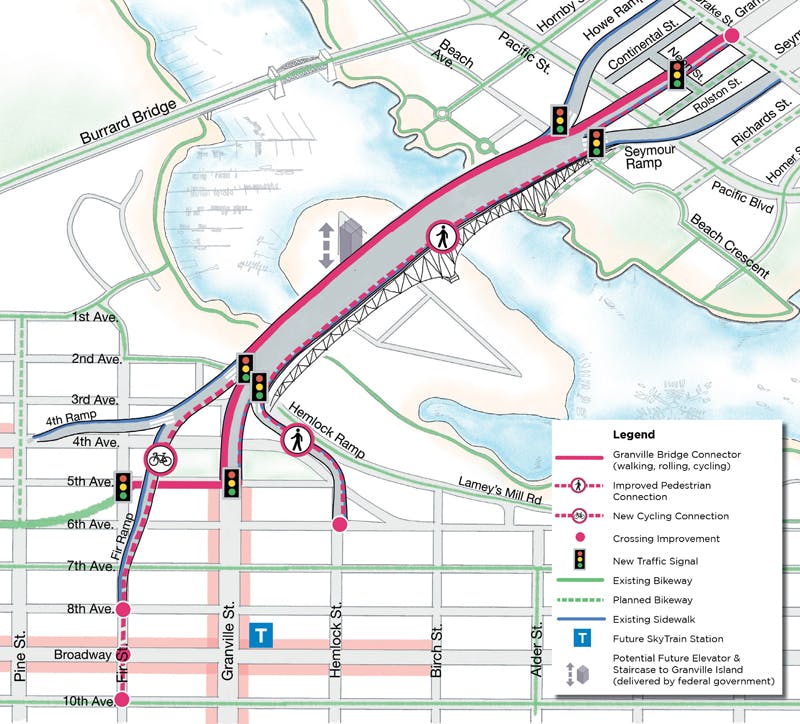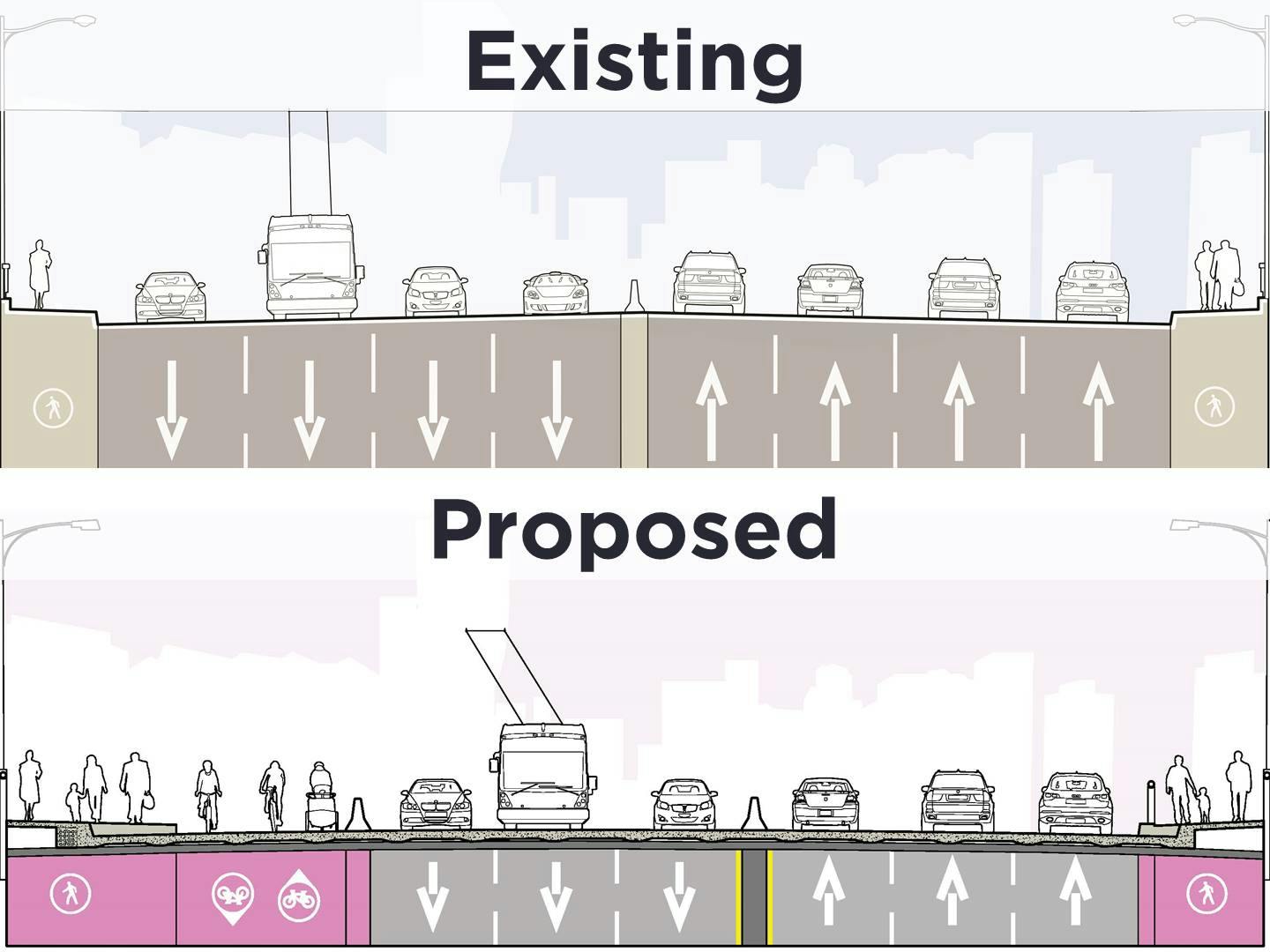Granville Connector
Consultation has concluded

We're developing conceptual plans for a new walking, rolling, and cycling path across the Granville Bridge.
Thank you to everyone who provided input on the project so far. Through three phases of engagement, we've heard from over 3,000 people at public open houses and workshops, and received over 9,000 survey responses!
We're recommending a refined version of the West Side Plus option that was shown in Phase 2, with changes based on public feedback.
See the key features of the West Side Plus option.
We're developing conceptual plans for a new walking, rolling, and cycling path across the Granville Bridge.
Thank you to everyone who provided input on the project so far. Through three phases of engagement, we've heard from over 3,000 people at public open houses and workshops, and received over 9,000 survey responses!
We're recommending a refined version of the West Side Plus option that was shown in Phase 2, with changes based on public feedback.
See the key features of the West Side Plus option.
-
Recommended Design - Key Features
Share Recommended Design - Key Features on Facebook Share Recommended Design - Key Features on Twitter Share Recommended Design - Key Features on Linkedin Email Recommended Design - Key Features linkCLOSED: This discussion has concluded.We're recommending a refined version of the West Side Plus option that was shown in Phase 2.
This was the option preferred by the public and a diverse range of stakeholders. Changes and refinements have been made based on feedback.
Key features include:
-
West side main path
- Wide, accessible sidewalk with room for furniture and special places at key locations
- Wide two-way bike path with room for passing
- Protective barrier between the bike path and motor traffic
-
East side sidewalk and Hemlock St ramp improvements
- Wide, accessible sidewalk
- Protective barrier between the sidewalk and motor traffic
-
Fir ramp cycling connection
- Relatively flat two-way cycling connection with 10th Ave bike route
-
Safe, accessible crossings at Howe St, Fir St, Hemlock St, and Seymour St ramps
- Traffic signals to allow for safe crossing
- Accessibility ramps to provide access for people using mobility aids
-
Connections to the network at each end
- At south end – via an improved W 5th Ave linking to Arbutus Greenway
- At north end – via proposed Drake St upgrades
- Future-proofed for potential Granville Island elevator and staircase
-
-
Current Challenges
Share Current Challenges on Facebook Share Current Challenges on Twitter Share Current Challenges on Linkedin Email Current Challenges linkCLOSED: This discussion has concluded.Granville Bridge's freeway-style design can create significant challenges for people walking, cycling, and rolling across the bridge.
-
Revised project goals
Share Revised project goals on Facebook Share Revised project goals on Twitter Share Revised project goals on Linkedin Email Revised project goals linkCLOSED: This discussion has concluded.The project goals were revised based on public feedback in Phase 1.
- Support our climate emergency efforts by enabling more trips via sustainable transportation
- Make walking, rolling, and cycling across the bridge accessible, safe, and comfortable for all ages and abilities
- Provide direct and intuitive walking, rolling, and cycling connections to key destinations and the sustainable transportation network
- Create a special place that provides an enjoyable experience for all
- Enable reliable transit and continued access for emergency vehicles
- Accommodate motor vehicles, considering the bridge’s role in the regional transportation network
- Integrate means prevention to deter self-harm
- Incorporate environmental features, including provisions for rainwater management and wildlife habitat
- Design for the future, considering compatibility with related projects and flexibility to adapt as the city grows
- Provide value for money and maximize coordination opportunities
The goals are important because they help inform the criteria to evaluate and compare different options.
-
Policy Background
Share Policy Background on Facebook Share Policy Background on Twitter Share Policy Background on Linkedin Email Policy Background linkCLOSED: This discussion has concluded.The project is important to accommodate the growing number of people living, working, and playing in the city and region. It is key to meeting our Climate Emergency mode share target that by 2030, at least two thirds of all trips in the city will be by active transportation and transit.
It was identified as a priority in the 2001 False Creek Crossings Study and in the City's Transportation 2040 Plan (approved in 2012) as a result of significant public engagement.
In January 2019, Council directed staff to launch a full engagement process.
Project timeline
-
Granville Bridge Connector timeline
Granville Connector has finished this stageHere is our timeline and anticipated milestones. The timeline is subject to change based on input and direction from Council.
-
January 30, 2019 - Council approval
Granville Connector has finished this stageCouncil approves moving forward with public engagement to confirm project goals and develop design options for the bridge.
-
April 2019 - Phase 1: Discuss goals | Share ideas & experiences
Granville Connector has finished this stageHelp us refine the project goals, share your experiences, hopes, and concerns about Granville Bridge, and generate ideas for the Connector.
-
September 2019 - Phase 2: Review shortlisted options
Granville Connector has finished this stageHelp us select and refine a preferred design by providing input on six shortlisted options that were developed with public input from Phase 1.
-
January 2020 - Phase 3: Review recommended design
Granville Connector has finished this stageHelp us refine the recommended design in more detail.
-
Spring 2020 - Council decision
Granville Connector has finished this stageStaff present the recommended design to Council for approval.
-
Detailed design & construction
Granville Connector is currently at this stageDetailed design and construction of project (pending Council approval).
Photos
FAQs
- What is the policy background on this project?
- Why are you doing this project? What challenges are you trying to address?
- How are you engaging with stakeholders and the public?
- What have you heard from the public and stakeholders so far?
- What are the goals of the project?
- Who would this project serve?
- How many people walk and bike over the Granville Bridge today?
- What about people who cycle on the sidewalk?
- What are the safety issues on the bridge?
- Will this project cause traffic congestion?







